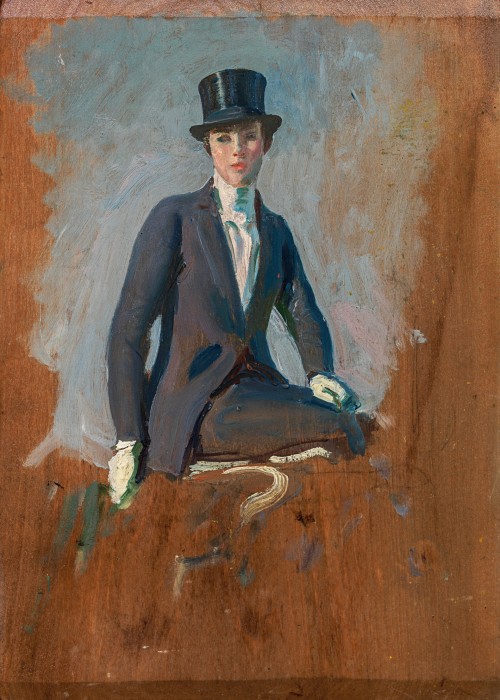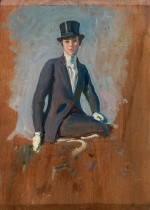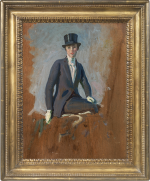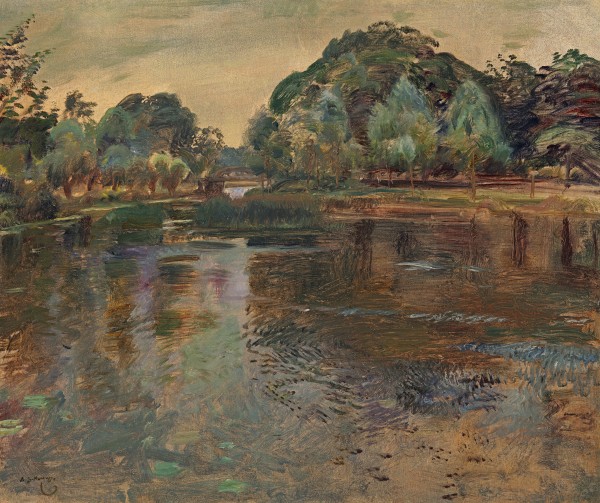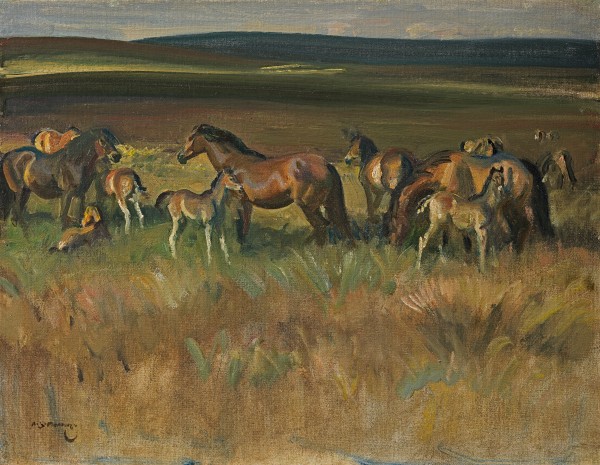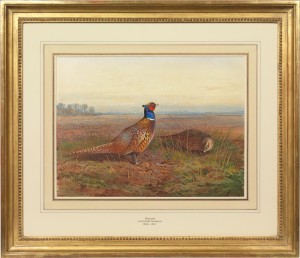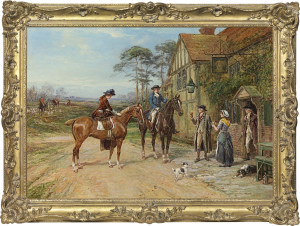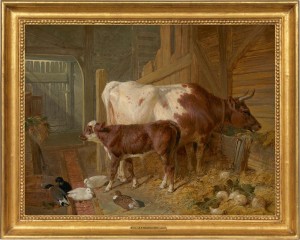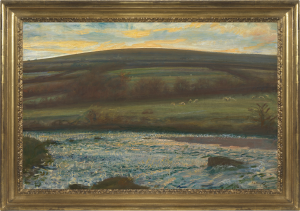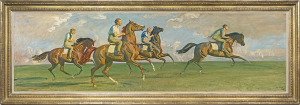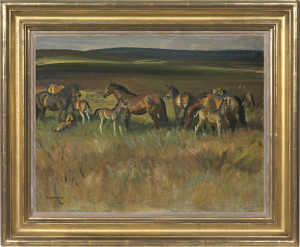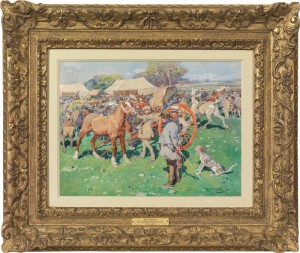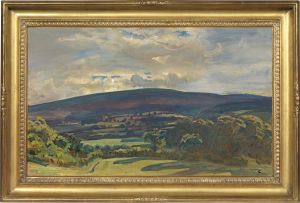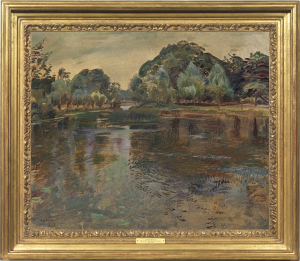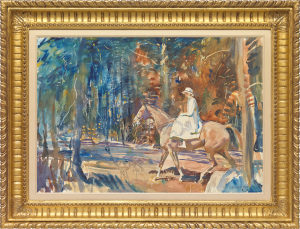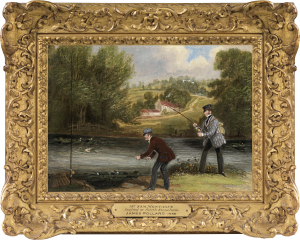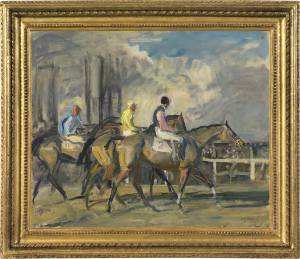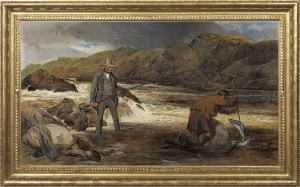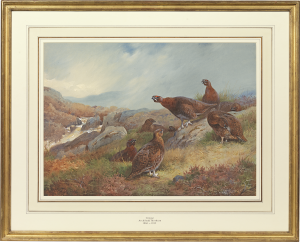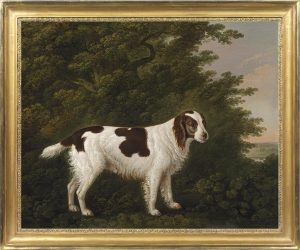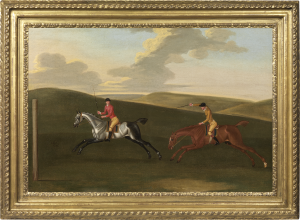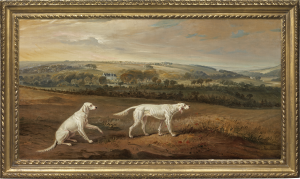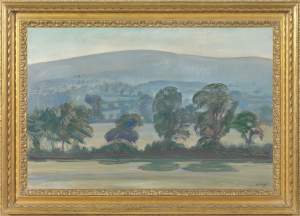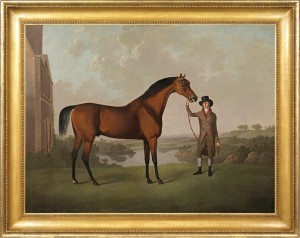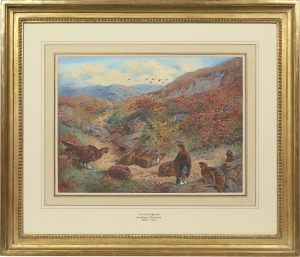Sir Alfred Munnings
A sketch of Miss Victoria Brady for 'Mrs Helen Cutting and Misses Brady' (RA 1935)
Oil on panel: 14.3 x 10.1 (in) / 36.2 x 25.7 (cm)
This artwork is for sale.
Please contact us on: +44 (0)20 7493 3939.
Email us
SIR ALFRED MUNNINGS KCVO PRA RWS
Mendham 1878 - 1959 Dedham
Ref: CA 108
A study of Miss Victoria Brady for Mrs Helen Cutting and Misses Brady (RA 1935)
Oil on panel: 14 ¼ x 10 1/8 in / 36.2 x 25.7 cm
Frame size: 16 ¾ x 13 ½ in / 42.5 x 34.3 cm
Painted circa 1935
Provenance:
Bond Street Galleries (James Green), London[1]
Wildenstein & Co., New York
Private collection, Rancho Santa Fe, CA;
by descent
Alfred Munnings became well acquainted with the Anglophile American upper class when asked to be a judge for the International Exhibition at the Carnegie Institute in Pittsburgh in 1924. He subsequently painted the young Paul Mellon and his horses and Mr and Mrs Frederick Prince, among others. Like the Princes, Americans of this set ‘thought no more of crossing the Atlantic than we would of crossing a street’[2], usually on luxury liners like the Berengaria, which had brought Munnings to New York.
Keen followers of the East Coast Hunts, Americans also hunted in Britain with fashionable packs like the Quorn and Belvoir, as well as at Pau in the south of France. This painting is a study for the central figure on a grey horse in Munning’s Mrs Helen Cutting and Misses Brady (private collection), shown at the Royal Academy in 1935. She is Victoria Mary Pery Brady (1915-1976)[3], daughter of James Cox Brady I (1882-1927) and his second wife Lady Victoria Mary Pery (1893-1918), daughter of the Earl and Countess of Limerick. Munnings liked to make several studies for the components of his large pictures, often isolating the figures and the horses. This sketch captures the elegant posture of the side-saddle rider and the light playing over her dark Busvine riding habit, the silk of her top hat and her white stock and gloves. In his autobiography, The Finish (1952), Munnings lamented that the fashion for women hunting side-saddle had largely died out after the Second World War: ‘I wish I had painted more women riding side-saddle…A good figure in a well-cut habit is the essence of grace and symmetry’[4].
Victoria Brady was a member of a prominent Catholic New Jersey family which Munnings had first encountered on his visit to America in 1924. Their fortunes had been founded by Anthony Brady, who made money developing New York gas and electric companies before diversifying into oil and tobacco. His son James Cox Brady I played an important role in the creation of the Chrysler motor Corporation. The Bradys had a large estate, Hamilton Farm, in the Somerset Hills, New Jersey, and hunted with the Essex Fox Hounds. While in America, Munnings painted Victoria Brady’s half-brother James Cox Brady Jnr. on Galty Boy, 1924 (Yale Center for British Art, New Haven, CT), and shortly after her half-sister Miss Ruth Brady on Bugle Call, c.1927 (private collection)[5].
Mrs Helen Cutting and Misses Brady was commissioned by James Cox Brady I’s third wife Helen McMahon, who had married him after Lady Victoria’s death in the Spanish Flu epidemic in 1918[6]. Munnings commented that this picture ‘was a generous commission, and I liked Mrs Cutting; she was a good-looker, and an individual, and I wish I could meet her again. I always got on with Americans’[7]. The third woman in the large painting is Victoria’s younger sister Genevieve (1916-1975), who married Anderson Fowler of Bedminster, New Jersey. The eldest of the Brady sisters, Ruth, married an Englishman, the Hon. Michael Scott (d.1938), son of Viscount Encombe, and the couple lived at Stockton House in Wiltshire. Munnings no doubt painted Victoria Brady, her stepmother and sister from life in England, using his own fine horses as models instead of the ‘first-class’ mounts from the lavish Hamilton Farm stables in far-off New Jersey. The rolling countryside is reminiscent both of England and the wide-open landscape of America’s East Coast, where fox hunting had been so successfully transplanted.
Alfred Munnings, Mrs Helen Cutting and Misses Brady, RA 1935.
Private collection.
SIR ALFRED MUNNINGS, PRA, RWS
Mendham 1878 - 1959 Dedham
Born in Mendham, Suffolk, Alfred Munnings was the son of a miller. He was apprenticed to a firm of lithographers from 1893 to 1898 and studied at the Norwich School of Art and in Paris. There he was impressed with plein-air naturalism; this, together with his introduction to the racecourse in 1899, influenced the themes for which he became famous.
While in Mendham, Munnings painted many scenes of country life, particularly horse fairs. He went to Cornwall in 1908, and for many years was an important addition to the Newlyn School of artists. When the First World War broke out, Munnings enlisted, despite having the use of only one eye owing to an accident in 1899. He became an army horse trainer near Reading and later went to France as an official war artist, attached to the Canadian Cavalry Brigade.
The year 1919 was a major turning-point in all aspects of Munnings's life; he painted his first racehorse, Pothlyn, the winner of the Grand National, and became an Associate of the Royal Academy. He met Violet McBride, whom he was to marry, and bought Castle House, Dedham, where the Munnings Memorial Trust maintains a permanent exhibition of his pictures. Munnings's prolific career, spanning over 60 years, brought him honour, with election to the Presidency of the Royal Academy in 1944, a Knighthood in 1945, and a personal award from the Sovereign in 1947, when he was created Knight of the Royal Victorian Order.
[1] Photograph in the Munnings Archive of James Green (Richard Green, London).
[2] Sir Alfred Munnings, The Second Burst, London 1951, p.338.
[3] Victoria married John Knox Cowperthwaite of Lamington House, Bedminster, New Jersey.
[4] The Finish, p.27.
[5] James Cox Jnr. and Ruth were the children of James Cox Brady I’s first wife Elizabeth Jane Hamilton, who tragically died in a rail crash in 1912.
[6] By 1935, when this painting was made, Helen McMahon Brady (1894-1961) had been widowed and remarried in 1932 to Charles Suydam Cutting (1889-1972), the explorer, spy and philanthropist credited with introducing the Tibetan Lhasa Apso dog to American society.
[7] The Finish, p.26.

